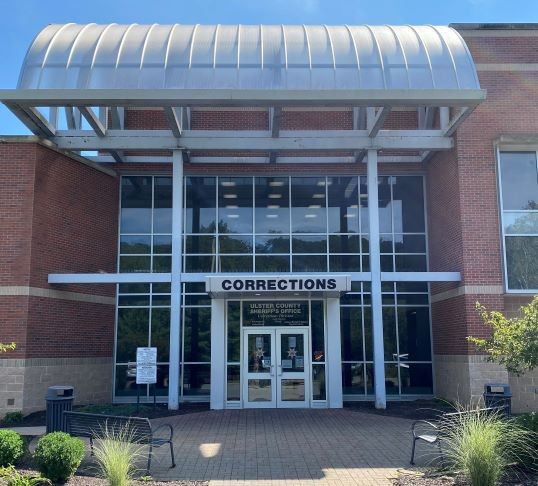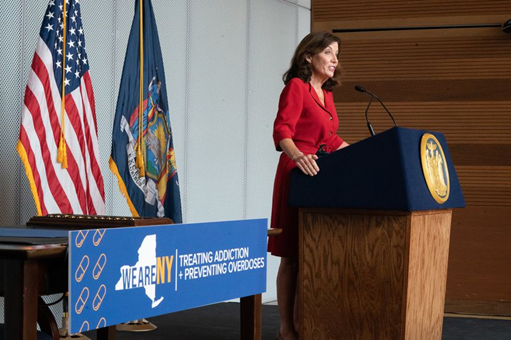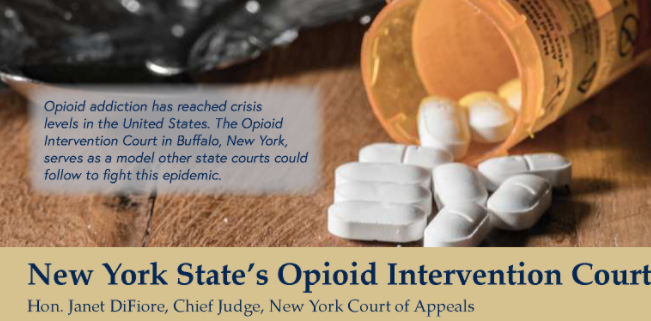
The factors contributing to the overdose crisis – a nebulous name for a real tragedy that has claimed almost a million lives in the US, over 107,000 in 2021 of which 80,816 contained opioids – are so overwhelmingly complex as to seem impossible to solve. Surely, no one agency or organization can address the crisis alone.
The HEALing Communities Study (HCS), a NIH-funded effort to reduce overdose deaths by 40% in New York and three other highly-impacted states, was built with just such a multi-agency, multi-disciplinary approach. Community partners include government agencies, non-profits, the medical field, and people with lived experience.
The criminal legal system – also referred to as the criminal “justice” system – is one HCS partnering sector, playing a crucial role in addressing this crisis. The role, historically, has not always been positive, which explains the movement to change the name from “criminal justice” to “criminal legal system” to reflect that reality. In fact, research shows that policing and racialized drug laws (such as severe sentencing for crack violations that resulted in 100 times the sentences of cocaine sentences) has led to many injustices such as the overrepresentation of Black individuals in the system.
How, then, can such a system help justice-involved people who use drugs – a disproportionate amount whom are Black and Brown individuals – rather than punish them, and prevent overdoses from occurring?
Below, we examine the new bill in New York requiring prisons and jails to provide access to medications for opioid use disorder, the innovative approach of one county to law enforcement, and the unique ways that HCS has partnered with law enforcement to save lives.
A New Bill Offers Treatment (and Hope)
Overdose is likely among people released from incarceration for two main reasons. First, they are often not given medication to treat their opioid use disorder or sometimes asked to discontinue from medications that are treating co-occurring mental health and substance use disorders. Medication for opioid use disorder, or MOUD, has proven an effective way to save lives as it manages cravings and discomfort of withdrawal, reduces relapse, lowers the chances of overdose death, and increases the time individuals stay in treatment.
Second, their tolerance for opioids has been reduced due to detox. Individuals often take a similar amount of drugs as they had pre-incarceration, and overdose. Additionally, the drug supply they may have been familiar with is constantly changing. Fentanyl, which is 50-100 times more potent than heroin, is now most commonly associated with fatal overdose in New York State.
A new bill in NYS – one of the first in the nation – requires MOUD be provided to incarcerated individuals detained in New York state’s county jails and prisons. The MOUD bill S1795 requires prisons and jails to provide access to all FDA approved forms of medications for opioid use disorder including the two most effective, methadone and buprenorphine.
As reported in Filter, the vice president of Legal Advocacy at Legal Action Center Sally Friedman said the bill will have “an enormous impact not only for the people cycled through jails and prisons, but also their families and communities.” Effectively, she continued, it will “keep people alive.”
Dr. Timothy Hunt, who has worked closely with the criminal legal system as part of his leadership role in the HEALing Communities Study, says “This is a critical opportunity to save lives through better screening, assessment and treatment during detainment with effective discharge planning and linkage to care upon release of people with substance use disorders.”
The bill includes provisions for systematic change such as thoroughly screening people with substance use disorders then offering all available medications approved by the FDA for opioid use disorder. Counseling services and discharge planning include linkage to medication, housing, employment, and other key social services.
Dr. Hunt continues: “This major system change is the result of decades of advocacy for the healthcare of those incarcerated with substance use disorder. Lawsuits, addiction experts, advocates and knowledgeable legislators raised awareness of the numerous stories of those who have died upon release from incarceration after treatment was withheld or sometimes discontinued during their stay in county jails and prisons.”

Similar MOUD bills across the country could also have a tremendous impact. Despite the bill’s promise, infrastructure and funding to implement it are unresourced. It is unclear how jails and prisons will manage to hire adequate staff for health and safety to meet the new demands. “I have had calls from other states including Colorado, Washington and our HEALing Communities Study partners in Kentucky, Massachusetts and Ohio asking about our experience in NY. This is a rare opportunity for rigorous implementation evaluation that can inform a national strategy,” Hunt states.
There is one Sheriff who has taken it into his own hands to ensure the availability of MOUD in his county and reset the mindset of law enforcement around people who use substances and the role of corrections in partnering with community services to link people to treatment and harm reduction strategies.
A Sheriff Seeks Nationwide Transformation of Approach to Law Enforcement and Treatment

“I lived through the crack epidemic. No one cared about people who looked like me.”
Juan Figueroa, New York’s Ulster County Sheriff, was the first elected Sheriff of Latino background in NY State history. After retiring from law enforcement, he decided to tackle what had harmed his family and community from another angle. He ran for Sheriff in 2018 to help his county “move away from an ‘us vs. them’ mentality toward one where law enforcement and the community work together as a team.”
As sheriff, he has embarked upon an ambitious new plan to reduce overdose deaths. Though based in Ulster county, his vision is grand: “I see this plan as a model for the entire criminal legal system nationwide.”
Prior to the approval of the new MOUD bill S1795, Sheriff Figueroa – in collaboration with partners including the Ulster County Executive Office, Offices of Health and Mental Health, the Bureau of Justice Administration and the aforementioned HEALing Communities Study (HCS) – created the Opioid Response as County Law Enforcement in Ulster County (O.R.A.C.L.E.).
O.R.A.C.L.E. was adapted from the Crisis Intervention Team model, an innovative public health approach to address the overdose epidemic and improve outcomes for individuals who have encounters with law enforcement. The program is designed to save lives instead of merely making an arrest. Its creation was also informed by Sheriff Figueroa’s understanding of the severe stigma faced by people who use drugs. To ensure the needed expertise and community engagement, the O.R.A.C.L.E. team includes both social workers and peers in a team with law enforcement serving people with opioid use disorder. “Unfortunately, law enforcement has been forced to address issues related to mental health that were outside their purview. This model of collaboration across professional disciplines with trusted community members, and accompanied by consistent team supervision built in can address complex challenges” Hunt stated.
“I want to thank Sheriff Juan for his genuine commitment to saving the lives of people who use drugs and for allocating his department’s funding towards implementing this program. This obviously reflects his belief that lives matter and his pledge to save lives of people who overdose,” said Dr. Nabila El-Bassel, the Principal Investigator for HCS and Director of the Social Intervention Group (SIG) at the Columbia School of Social Work.
The model is a community-oriented approach where social workers and case managers work in a team with police to respond to 911 calls that involve drug overdose situations. This model requires a tremendous paradigm shift regarding how the police respond to people who use drugs. Instead of arresting the individuals, the O.R.A.C.L.E. team links them to treatment and care.
“Changing that mentality toward these individuals was key to getting buy-in with staff,” Sheriff Figueroa said. But transforming attitudes and beliefs requires long-term commitment. “It’s important to have discussions, to phase it in.”
[Related: ORACLE receives national recognition.]
Buy-in was achieved from several staff, including an officer who was so inspired by his work on the O.R.A.C.L.E team and returned to school to get his Credentialed Alcoholism and Substance Abuse Counselor (CASAC) certification.
Dr. Hunt says “The team approach and respect for each other's perspectives builds trust in the community and for those who may be seeking help.”
Upon release from incarceration, team members work on housing and food insecurity– the most immediate needs, share harm reduction strategies including overdose education and naloxone (Narcan) kits, and link them to treatment within the community. This team supports each individual for one year by assigning a peer recovery coach. The coach helps the person navigate a return to their community, including establishing housing and employment. The coach also links them to treatment including maintenance of MOUD, as needed. In addition to serving those incarcerated, the O.R.A.C.L.E team also responds to 911 calls where an overdose is suspected and offers the same voluntary support and linkage to care at this extremely sensitive and critical time in a person's life.
The creation of O.R.A.C.L.E. was possible due to a $900K grant from the Bureau of Justice Administration and the groundwork laid by members of HCS, who co-wrote the grant spearheaded by Juanita Hotchkiss and convened specific organizations and individuals to support the partnerships required to implement this cross systems approach to engaging those with SUD touched by law enforcement.
Dr. El-Bassel says though the program is important and demonstrated positive results, “By itself, this intervention cannot sufficiently address Ulster County’s drug overdose problem or reduce the number of drug arrests. Far too many barriers exist that need to be rectified first, in order for the O.R.A.C.L.E. program to work well.”
Dr. El-Bassel agrees with Sheriff Figueroa’s compassionate approach with people who use drugs, and his attempt to change the culture of policing. “Historically, police ideology, approaches, and practices have been military-oriented and punitive. This must change, if significant outcomes are going to be achieved such as reducing the number of arrests among people of color.”
Dr. El-Bassel recommends two other significant changes. “Occupational rewards and incentives for police officers who make a greater number of arrests – both financial and promotional – must end. Second, police have often exhibited high levels of racism against Blacks and other communities of color and this has led to a higher incidence of arrests. These many racial-profiling arrests must be addressed.”
Indeed, one of the main challenges Sheriff Figueroa faces as part of law enforcement is engaging communities of color, who are understandably wary. He noted that people may not call 911 when a loved one is overdosing out of fear of harm or arrest. He is unrelenting in his message in Ulster county: People will not be arrested for calling 911 for an overdose. The person whose life is saved will be given the option for treatment.
Sheriff Figueroa, however, needs the commitment of his fellow law enforcement staff. In addition to law enforcement, nurses and providers within incarcerated settings need to foster similar partnerships with social workers. Dr. El-Bassel advises O.R.A.C.L.E. success will depend on:
- Funding for training of corrections and administrative staff – not just the officers
- Reducing the number of arrests and incarcerations
- Changing the ideologies of law enforcement and its concomitant system of financial incentives and promotional rewards for higher arrests
- Changing militaristic and punitive approach by the police including “stop and frisk,” which is often used to intimidate the community
- Reducing stigma against people who use drugs
Without addressing all of these issues, Dr. El-Bassel cautions, the impact of the O.R.A.C.L.E. model cannot be sustained.
[Related: When bail reform comes, we must do far more to help people who use drugs]

A nationwide adoption of the O.R.A.C.L.E. model has the potential to drastically reduce the number of people who die from overdose. In addition, the model itself can be adapted to other social dilemmas, such as gun violence or mental health crises. In addition to the investment outlined above, a nationwide launch success depends upon a collaboration between community agencies, individuals, and organizations. Beyond these collaborations, it is imperative that individuals feel safe enough to call for help, and that those they are calling will respond compassionately.
Sheriff Figueroa’s efforts to engage communities from which he arose will surely succeed by destigmatizing people who use drugs, and by providing adequate support through this groundbreaking Bill and O.R.A.C.L.E., and continuing to seek a diverse range of perspectives informing solutions – including from the people directly impacted.
Next, we explore other creative ways to partner with the criminal legal system to save lives.
Creative and impactful ways to partner for justice
The partnership between the sheriff’s office in Ulster county and the HEALing Communities Study is only one example of how HCS has actively partnered with the criminal legal system and programs to achieve their goal of saving lives, and how other studies may also approach these partnerships.
At the heart of HCS are its people, specifically a coalition of individuals from government agencies including elected officials, people and family members with lived experience, healthcare providers, emergency departments, programs that assist the unhoused, youth-serving organizations. and more.

This wealth of diverse perspectives resulted in additional collaborations that reimagined how the criminal legal system can work with those impacted by substance use rather than against them. In Greene county, the HCS study team helped launch their first opioid court by convening key members of the community and laying the groundwork through the HCS funded technical assistance provided by the Policy Research Associates Gains Center. “The partnership between our HCS Greene County Coalition, the Unified Court System, PRA Associates and an empathic and experienced Judge serving as a champion were key ingredients to the launch of this treatment court to improve access to treatment for those with opioid use disorder,” Dr. Hunt stated.
[Related: How One Community is Pursuing an Opioid Court to Address the Overdose Epidemic]
In Putnam county, the HCS program manager Kristin McConnell and Sheila Hanley spearheaded the partnership between the prevention council and probation to help link people to treatment. As with the creation of O.R.A.C.L.E. in Ulster, this achievement took time as not everyone at probation saw the linkage to Naloxone distribution as their job, initially. The partnership between HCS, the prevention council and probation allowed people under community supervision to have access to overdose education and naloxone (narcan) kits.
Dr. Hunt recalled that the “initial conversations were at times uncomfortable given the differences in organizational and professional missions. The team understood the dual focus: Probation and compliance with court requirements, as well as the health of people using drugs and the need to prevent overdose. It is a real acknowledgment that people with substance use disorders at different stages of recovery do relapse and need the tools to stay alive.
Nationwide Implications for the Criminal Legal System
HCS, with partners including the New York State Department of Health (DOH), the Office of Addiction Services and Support (OASAS), and the Office of Mental Health (OMH), remains committed to supporting NYS communities providing services to those with Substance Use Disorder and appropriate for Medications for Opioid Use Disorder (MOUD) or Medication Assisted Treatment (MAT) in jails and prisons to comply with new regulations through the provision of technical assistance, tools and community engagement needed to be successful. Lessons learned from this partnership can provide a roadmap for other states advancing services for those with SUD.
Correctional health leadership in counties have expressed their main concern is the engagement of community partners to provide access to needed services for those being released from incarceration. Law enforcement recognizes the mandate to partner with professional experts in the treatment of substance use and mental health disorders in order to effectively reduce harms and to improve the quality of life and safety of those impacted. The call to action includes greater coordination, training and collaboration between law enforcement and community-based health and social service providers to increase continuity of care and to reduce relapse and potential reincarceration or worse, fatal overdose of those with SUD and co-occurring mental health challenges. Coalitions, such as those championed by the HCS, with membership of community providers, county leadership and those directly impacted by substance use are needed to promote empathic, skilled, efficient and timely coordination of services now required by NYS legislation.
